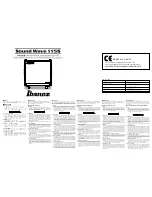
6
3.3. Signal input connections
The signal input connectors are of XLR-3 type (11), electronically balanced. The pin assignment is as
follows:
HOT or direct signal
>
Pin 2
COLD or inverted signal
>
Pin 3
GROUND
>
Pin 1
For unbalanced connection short-circuit pin 3 to pin 1.
The "STK OUTPUT" (10) are in parallel with the inputs and are used to supply the same input signal to
other amplifiers or sound systems.
The input impedance is 20K
Ω
(balanced) with a nominal input sensitivity of 0dBV(1V). This impedance
makes possible to parallel several amplifiers without loosing audio quality.
3.4. Subsonic filter
This filter cuts off inaudible frequency components which when amplified suppose a risk of damage to the
low frequency speakers as they generate excessive excursions of the woofer's diaphragm. The DPAs feature a
switchable, Butterworth shaped Subsonic Filter located inside the unit (see fig.) with a 25Hz cut-off frequency and
18dB/oct slope.
Subsonic filters are very important when playing back vinyl records because the phono cartridges are
specially sensitive to feedback and acoustic coupling at very low frequencies.
DPA amplifiers are delivered with switched ON Subsonic Filter.
CAUTION: Changes on the Subsonic Filter have to be performed by a qualified technician.
3.5. Limiter circuit
The high output power models DPA2500T/4000T additionally feature the A
2
SP –System (Analogue
Autogain Signal Processor), that consists in an VCA (Voltage controlled Amplifier) controlling the Input Signal gain
in high stress situations at very low load impedances (2
Ω
or lower). As opposed to conventional compression or
limiting techniques, the side-effects are not noticeable and most important, neither dynamic range is reduced nor
THD is increased. For transients shorter than 150 ms, it limits so that 10% THD is allowed, while for transients
longer than 150 ms, a maximum THD of 0.1% is allowed. Furthermore, these models include a thermal sensor
inside the transformer that also contributes in controlling the A
2
SP in case of reaching a critical temperature that
could be dangerous to any of the two power transformers.
3.6. Output connections
The "OUTPUT" section on the back panel is provided with Speakon® connectors (13).
To operate the amplifier on "BRIDGE" mode, place the "STEREO BRIDGE" switch (12) to the "BRIDGE"
position. The correspondent Led on the front panel will lit. The input signal must be connected to the channel I
connector while the output signal will be present on the Speakon® connector labelled as "BRIDGED".
Please make sure that the resulting impedance of your installation, when the amplifier is operating in
BRIDGE mode, is never lower than 4 Ohm (8 Ohm recommended).
The connection cable that joins the amplifiers outputs and the loudspeakers must be of good quality,
sufficient section and as short as possible. This is most important when the distances to cover are long ones i.e. up
to 10 meters it is recommended to use a section not inferior to 2.5mm
2
and for superior distances 4mm
2
.







































